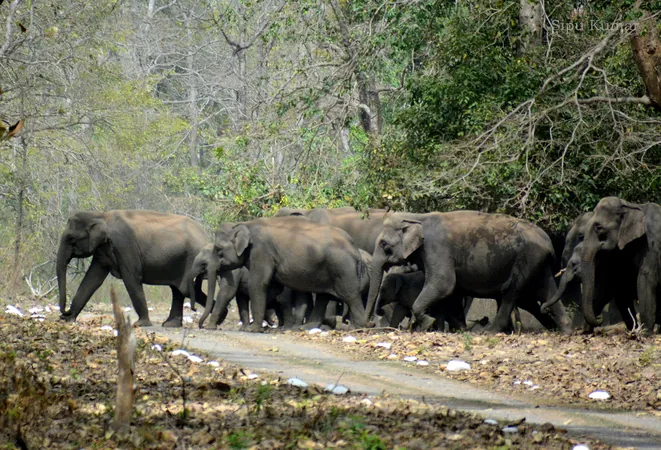
New Genetic Insights Reveal Diverse Elephant Populations in India
2024-11-01
Author: Mei
Introduction
Asian elephants, one of the most studied species in India, continue to reveal the complexities of their genetic history through groundbreaking research. A recent study has unearthed astonishing revelations about the Asian elephant populations in India, identifying five genetically distinct groups and suggesting a lineage that stretches further back in time than previously believed.
Research Overview
Uma Ramakrishnan, a prominent professor at the National Centre for Biological Sciences (NCBS), emphasizes the significance of using animal genomics to piece together the history of wildlife in India. She stated, "It’s fascinating to use DNA to reconstruct the past of various wildlife species. As we continue this work, we gain crucial insights into India's wildlife history.” This exploration gains added urgency as habitat fragmentation and booming human populations pose increasing threats to wildlife, particularly over the last two centuries.
Genetic Diversity Findings
Boasting nearly 30,000 Asian elephants, India is home to a substantial 60% of the world's Asian elephant population, which spans across South and Southeast Asia. Researchers from NCBS and the Indian Institute of Sciences (IISc) conducted an extensive analysis using blood samples from both wild and captive elephants. Their findings delineate five distinct populations: one each in northern and central India, and three situated in southern India.
Significance for Conservation
Conservation ecologist Aritra Kshettry from WWF-India heralds this study as a monumental leap in elephant conservation, shifting the understanding from three to four known populations to five recognized genetic groups, with the north and northeastern populations forming a unified cluster.
Geographical Barriers and Health Implications
One of the surprising findings includes the identification of the Shencottah Gap in southern India as another potential geographical barrier affecting the elephants’ genetic diversity and dispersion. The population south of this gap is notably distinct and exhibits lower genetic diversity, making it more susceptible to environmental pressures.
Long Divergence Estimation
The research also speculated on the long divergence of these populations, estimated between 20,000 and 70,000 years. Anubhab Khan, the study's lead author, explained that the history of these elephants reflects their migration patterns, which have substantial implications for their genetic makeup. As populations migrated, certain harmful genetic variants became diluted, resulting in varied health impacts across regions.
Cautions about Southern Populations
Even though the southern population shows fewer deleterious genes, Khan cautioned against assuming they are overall healthier. Increased homozygosity due to inbreeding, a common issue in isolated populations, could elevate the risk of adverse health effects, complicating the narrative regarding their fitness.
Implications of Genetic Research
These findings illustrate a "serial founder effect," often observed in populations that migrate, suggesting that limited individual migrants establish new populations, inadvertently carrying along detrimental genetic traits.
Conservation Strategies
The implications of this genetic study extend far into conservation practices. Genome sequencing can facilitate the creation of a specialized SNP (single nucleotide polymorphism) panel for identifying individual elephants. Such advancements can aid conservationists in protecting these majestic creatures from poaching, as genetic data can trace seized elephants back to their specific populations.
Urgency of Conservation Efforts
Moreover, the study underscores the urgency of prioritizing conservation efforts for smaller, vulnerable populations. With elephant-human conflicts on the rise, particularly as elephants venture closer to human settlements, the integration of genetic research into conflict management strategies is imperative. Tarsh Thekaekara, a researcher from The Shola Trust, advocates for evolving from reactive to proactive, science-based solutions to mitigate wildlife conflicts.
Conclusion
As researchers continue to unlock these genetic mysteries, the hope is that their findings will not only inform elephant conservation strategies but also enrich our understanding of wildlife ecology in India. The future of these gentle giants depends on both our knowledge and our commitment to preserving their intricate histories and habitats.




 Brasil (PT)
Brasil (PT)
 Canada (EN)
Canada (EN)
 Chile (ES)
Chile (ES)
 España (ES)
España (ES)
 France (FR)
France (FR)
 Hong Kong (EN)
Hong Kong (EN)
 Italia (IT)
Italia (IT)
 日本 (JA)
日本 (JA)
 Magyarország (HU)
Magyarország (HU)
 Norge (NO)
Norge (NO)
 Polska (PL)
Polska (PL)
 Schweiz (DE)
Schweiz (DE)
 Singapore (EN)
Singapore (EN)
 Sverige (SV)
Sverige (SV)
 Suomi (FI)
Suomi (FI)
 Türkiye (TR)
Türkiye (TR)